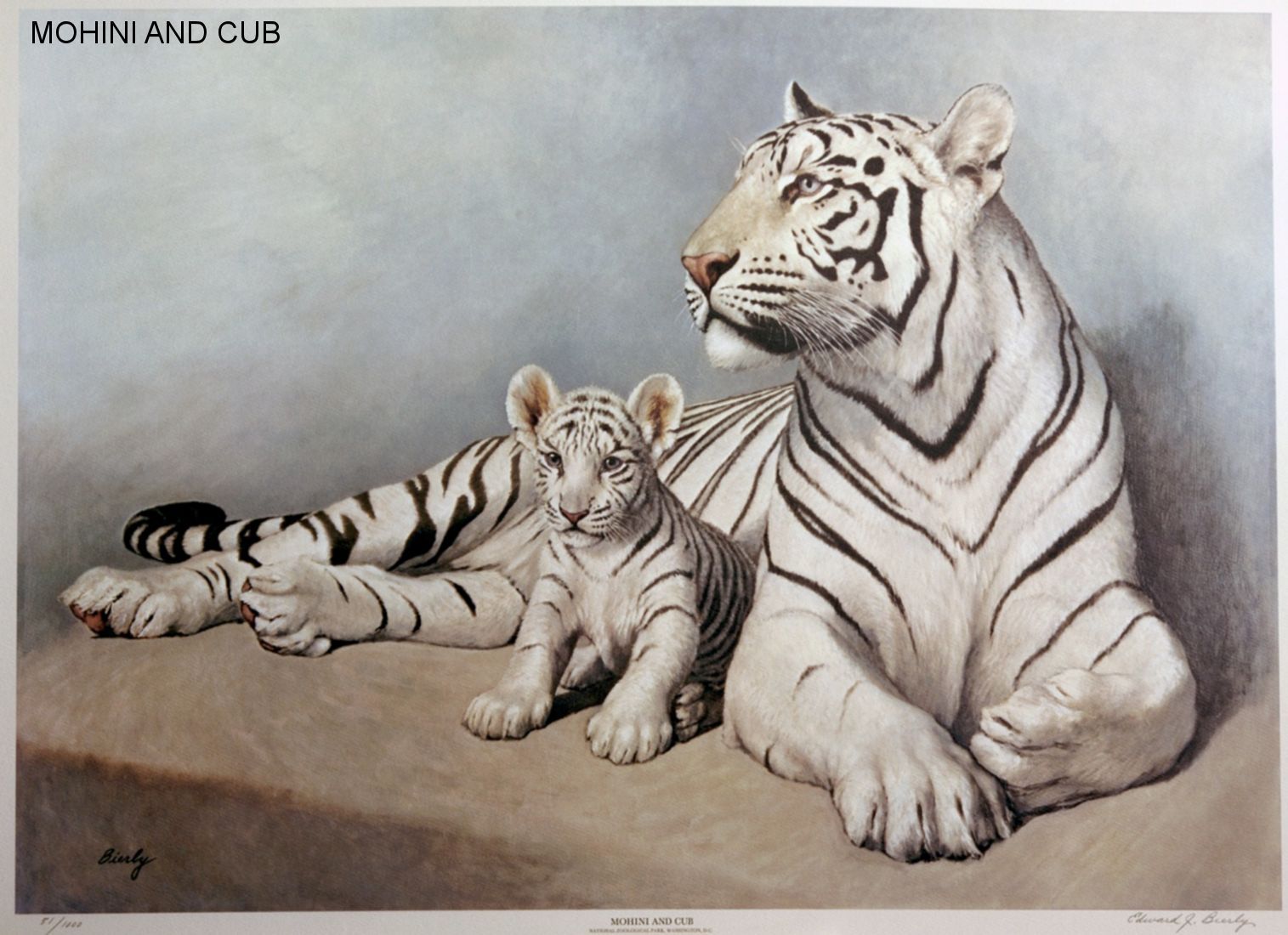
|
WHITE TIGERS - MOHINI, MOTHER OF AMERICAN WHITE TIGERS, AND HER DESCENDANTS |
Historical quotations are credited and are in the public domain. Original text is licensed under the GFDL. I am grateful to Paul McCarthy and Jerry Blackman for researching and providing extensive material, information and corrections on white tigers and for genealogies.
White gene vs Inhibitor gene.
Although these pages refer to white genes, white tigers have the genes for normal orange colours, but those genes are switched off by a recessive inhibitor gene. When a tiger inherits 2 copies of the inhibitor gene, the normal orange colour is suppressed. In general parlance, it s simply easier to refer to white genes.
MOHINI, MOTHER OF AMERICAN WHITE TIGERS
Mohan was bred to his daughter Radha, resulting in 4 white cubs on October 30th, 1958: Raja ("ruler" or "king"), Rani, Sukeshi and Mohini ("Enchantress") that carried 75%. Mohini, the daughter of Mohan and Radha, was born at Rewa in October 1958. After the Maharajah successfully bred white tigers at Govindgarh Palace, the Indian government banned the export of white tigers, declaring them a living treasure. When Eisenhower visited New Delhi in 1959, a white sister of Mohini was brought from Rewa to show him. Washington attorney Ralph S Scott had suggested to the German-American billionaire John W Kluge that he buy a white tiger for Washington Zoo as a gift for the children of America. So in 1960, Kluge bought a white tigress from the Maharajah for $10,000 as a gift for the US National Zoo (NZP) in Washington DC, but the Indian government refused to let it out of India. Negotiations included President Eisenhower appealing to Prime Minister Nehru to release Mohini from India. Finally Mohini was officially presented to President Eisenhower on the White House lawn. She was a great attraction and the zoo wanted to breed more white tigers.

A person instrumental in bringing Mohini to the USA was Patricia Hunt. In "Life" magazine Vol 56, No 6, Feb 7, 1964, the "Editor In Charge Of Whales, White Tigers, and Sifakis" column by George P Hunt (no relation) wrote "[Patricia Hunt] once found a story in the ad columns of The New York Times, in which an Indian maharaja was offering white tigers for sale. Her cables and her interest resulted in the sale of a white tiger to a U.S. zoo, for which the maharaja was duly grateful."
Ralph S. Scott, who was instrumental in bringing Mohini to the United States, said that at one point the United States Ambassador to India had her placed in an Embassy truck with Marine guards, because of all of the difficulty they were having getting her out of the country. Prime Minister Nehru of India had wanted the first white tiger to be exported from India to go to Beijing Zoo, and not Washington DC. One of the events that influenced Mohini's fate was developments in Tibet, which resulted in the Dalai Lama fleeing from the Chinese to India. A wave of anti-Chinese sentiment swept India and Mohini went to the US National Zoo instead. Dr. Theodore H. Reed, the director of the National Zoo, had spent 6 months in India trying to cut through the red tape; Reed unsuccessfully tried to buy a white tiger for Clyde Beatty. Reed had been given a free choice and could have chosen Sukeshi, Raja, Rani or Mohini, for the Washington Zoo. Ralph S. Scott, was a big game hunter who had discovered white tigers on his way home from Nepal when he was a guest of the Maharaja of Rewa; he acquired an orange Bengal tiger named "Uncle Samson," a heterozygous son of Mohan and Begum, as a mate for Mohini in 1963.
Of Mohini, TH Reed said "Her stripes were black, shading into brown, but her main coat was eggshell white instead of the normal rufous orange. Exotic coloring and magnificent physique made her a tiger without peer [...] For a two-year old kitten, she had tremendous growth-almost 190 pounds, three feet tall at the shoulders, and eight feet long from nose to tail." . Reed selected Mohini out of a litter of four white cubs.
Mohini stayed overnight at Bronx Zoo where Crandall was director. She also spent one night at the Philadelphia Zoo, en route to Washington. Crandall described the arrival of Mohini, and later her consort, thus: "On November 30, 1960 a "white" tiger that had been presented to the National Zoological Park by John W. Kluge of the Metropolitan Broadcasting Company arrived here for an overnight stay. It was forewarded to Washington on Dec. 1. This animal, bred in the collection of the Maharaja of Rewa, in central India, was a well grown female about 2 years old. It's ground color was nearly white with faint cream overcast, and the stripes were sooty black. The eyes, reported as blue, appeared green to me. [...] On January 6, 1963 a normally colored male Bengal tiger arrived at the National Zoological Park, Washington, from the zoo at Ahmedabad, India. Bred under the direction of the Maharaja of Rewa, this animal is both half brother and uncle of the "white" female recieved in 1960. On January 6, 1964 the female gave birth to three cubs, of which one was white."
Ralph S. Scott, President of the Zoological Society of Florida, brought back at least two wild caught orange tigers for loan to the National Zoo, including a male named "Mighty Mo", who was paired with Mohini for breeding, without success, so he was replaced by "Uncle Samson" from Ahmedabad Zoo. Mighty Mo is not in the studbook and was was later transferred to Pittsburgh Zoo. Samson, was a more assertive mate. In a Miami Herald article from Dec. 1, 1960, Scott referred to Mohini (of Rewa) as "Princess" and said that Mighty Mo, her intended mate, was in the cage next to her. Mighty Mo had been captured in central India in 1959 as a cub. He was then exhibited at various branches of a restaurant chain before being formally presented to the National Zoo by J. Willard Marriott, Sr. Because no more white tigers were being allowed out of India, NZP mated Mohini to Samson (her mother Radha's brother, imported to Washington from Ahmedabad Zoo, India in 1963), her orange uncle and half-brother (thanks to inbreeding) who carried the white gene. One of their offspring, Ramana, was mated back to Mohini resulting in the white female, Rewati. When first introduced, Sampson bit off part of Mohini's ear! Unfortunately, inbreeding depression was starting to show up; Rewati had a crooked spine and short limbs and at one point her hind legs were paralyzed and she was crawling in circles.
Ramana and his orange sister Kesari had a litter of three white tiger cubs, and one orange, at the Cincinnati Zoo on 20th June 1974. These four cubs were the last (studbook) registered (pure-bred) Bengal tigers born in the Western Hemisphere. Cincinnati Zoo claimed that the NZP had tried and failed - to breed Ramana to Kesari, only for the pair to breed almost as soon as they reached Cincinnati. These cubs went to either Port Clinton, or Sandusky, Ohio, or Grand Prairie TX. Bharat, Priya, and Peela were sold to the International Animal Exchange, Sandusky, Ohio. Ranjit, Priya, and Peela went to the IAE s facility in Grand Prairie, Texas. Ranjit and Bharat were then sold to a zoo by the IAE the name of the zoo was originally secret, but it was believed to be a zoo on the island of Formosa (an old term for Taiwan). Taipei Zoo state they had no white tigers in the 1980s (personal correspondence). John Seidensticker of the US National Zoo told a correspondent that Ranjit, Bharat, Priya, and Peela were all sold to a zoo in South Korea. The Honolulu Advertiser Wednesday December 21, 1988 (p 64) said there was a one month old white tiger cub at Grand Prairie, Texas, but didn t state if the cub was born there - this may have been Priya's cub, sired by Ranjit. At the time Ranjit, Priya, and Peela were there.
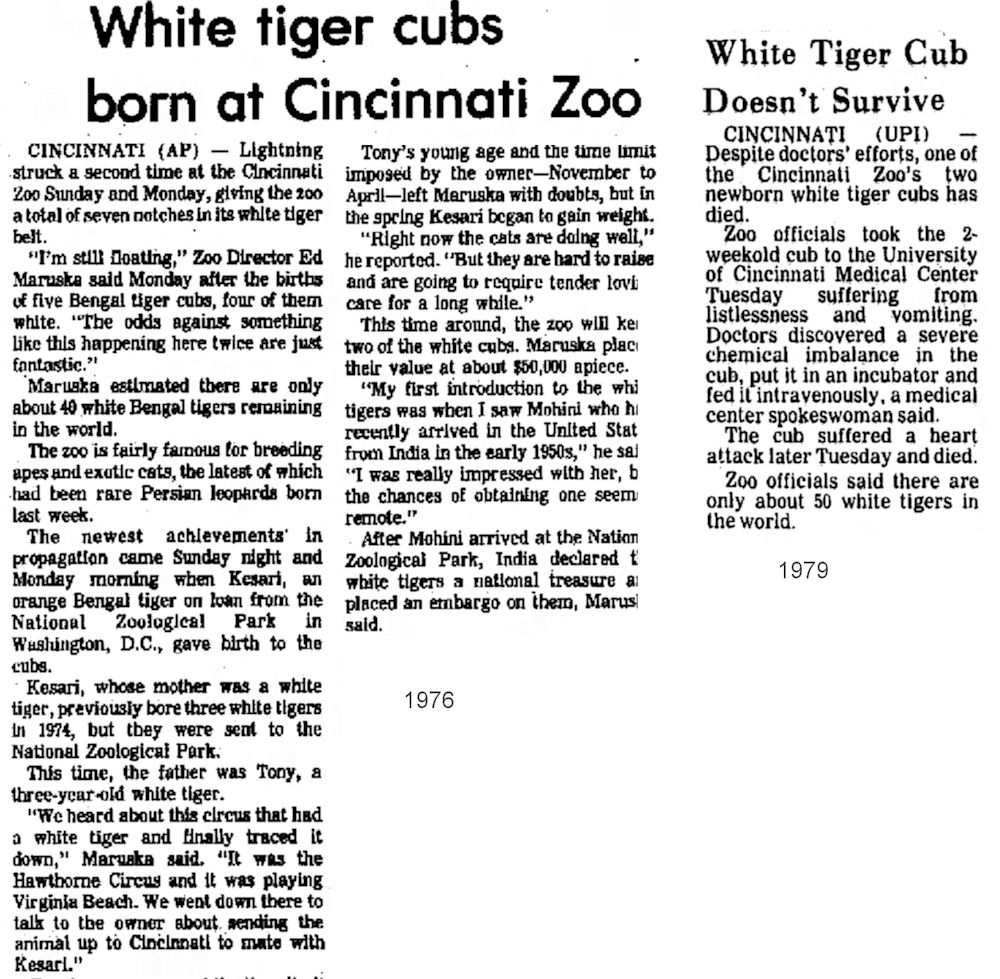
(In 1960 the mayor of Los Angeles visited the National Zoo to see Mohini Rewa and ask how to get a white tiger for Los Angeles Zoo. T.H. Reed told the mayor that the only realistic way that could happen was to acquire one of Mohini s offspring. In 1970 the Los Angeles Zoo had started construction of a white tiger exhibit. Ralph S. Scott said he would consider donating a pair of white tiger cubs to the Los Angeles Zoo. In 1970 there was a bidding war between Ralph S. Scott, Jimmy Stewart's wife, a pro baseball team, a movie studio, and possibly others. Ralph S. Scott contacted the Maharaja of Rewa and sked him to stop the bidding war and name a fair price and Scott would pay it. In 1970, the Maharaja had permission to sell two pairs abroad. One pair went to Bristol Zoo and a white female went to Crandon Park Zoo, leaving a white male that that was probably the subject of the bidding war. When the Los Angeles Zoo finally got their white tiger in the 1980s Jimmy Stewart hosted a fundraiser to pay for it.)
Chart 03: Mohan's Line via Mohini in the USA (large image, opens in new window)
In 1964 - one year and one day after Samson's arrival - Mohini and Samson produced orange male Ramana who was bred to Mohini after Samson's death. The Mohini-Samson mating also produced white male Rajkumar - the first white tiger born in a zoo (said to have a particularly nasty temperament!) - who survived only 10 months before he and his orange sister, Ramini, died of feline distemper. The claim of panleucopenia is contradicted by Sankhala and Roychoudhury. They say that Rajkumar died on July 27, 1965 and Ramani on July 7, 1965. Rajkumar was supposed to have had a terrible disposition. All three cubs were vaccinated against panleucopenia, but two of them appear to have died from it anyway. According to the Smithsonian annual reports the zoo had seven Bengal tigers in 1964: Samson, Mohini, Rajkumar, Ramana, Ramani, Mighty Mo (Mohini's original mate), and another male Bengal tiger (in 1961 they had only three, including Mohini). Going through subsequent issues year by year there is no report of Mighty Mo leaving the zoo or of his death.
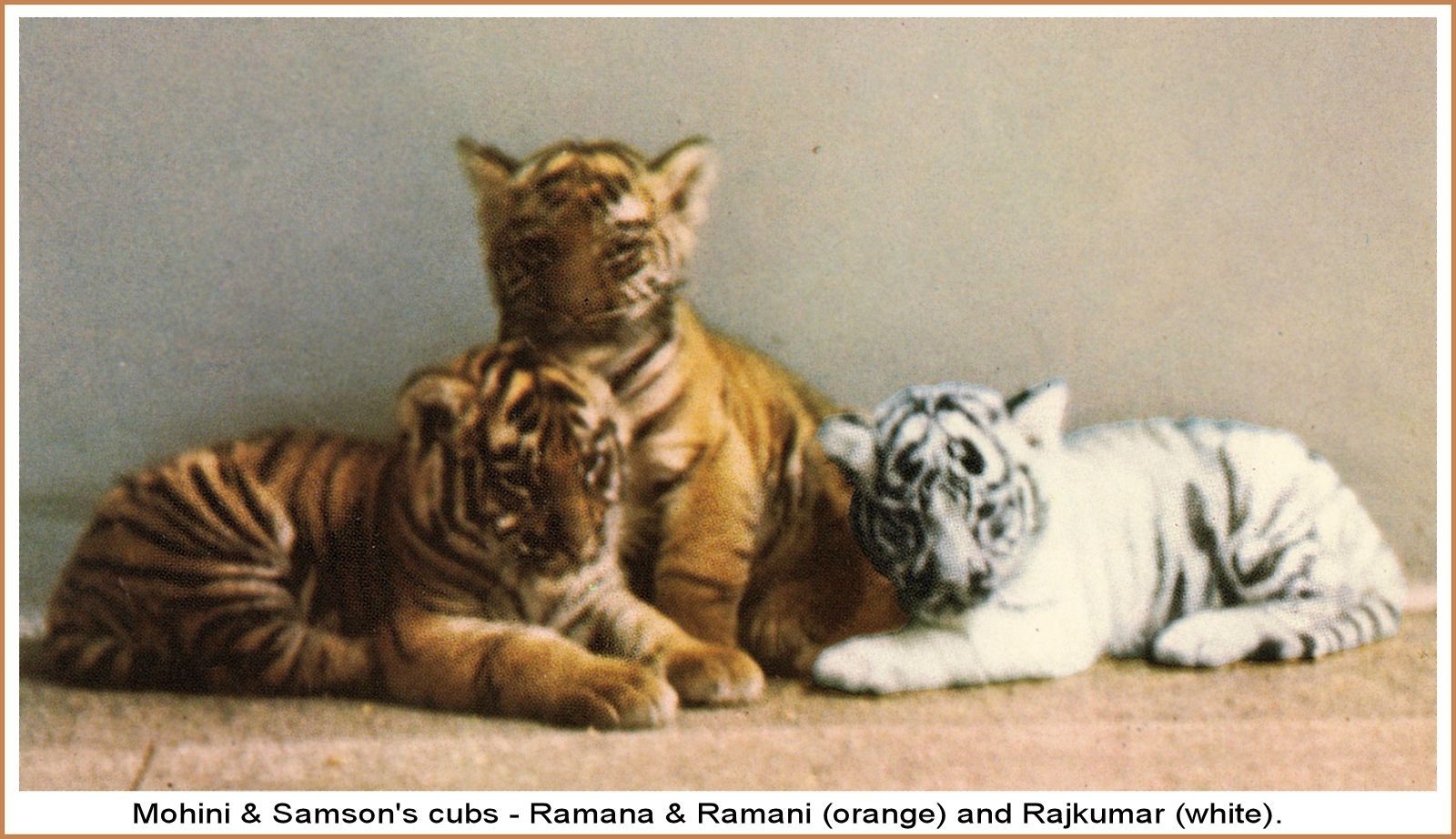
According to Smithsonian annual reports at the time: "Until the cubs [Ramana, Rajkumar and Ramini] were 6 weeks old the Lion House was closed to the public . . . When they were first put on exhibition they were so popular that it was necessary to put a sign on the cage asking visitors to move on and let others enjoy the scene; some people actually arrived in the morning and spent the entire day standing in front of the cage until the building closed in the evening. A film of the birth, combined with a film made at the palace of the Maharaja of Rewa in India, was shown on a half-hour nation-wide television program." One of the cubs was unusually light orange in colour, probably due to a condition called fever coat where high temperature in the womb prevents pigment from forming properly. T.H. Reed wanted to trade the entire litter including the white one to another zoo for an assortment of animals, including zebras, but the Secretary of the Smithsonian vetoed the deal.
In 1966, Mohini and Samson produced orange daughter Kesari; no other cubs from that litter, which included white cubs, survived. In 1969, Ramana and Mohini produced cross-eyed white female, Rewati (she also had a crooked spine, short limbs and at one point her hind legs were paralysed). Their next litter had 2 white and 3 orange cubs, but only white male Moni survived.In a tragic accident, after 48 hours Mohini crushed and killed three of the cubs while in labour with a fifth (stillborn) cub. The surviving cub, a white male named Moni was hand-reared by Elizabeth Reed. Moni was the last white tiger born in Washington and died of a neurological disorder. Moni also had a twisted neck, something previously seen in the Delhi Zoo s white tigers. He had just received a lot of medical treatment at John Hopkins before he died. Moni was the first white tiger in whose brain the visual pathway abnormality was first documented. None of Mohini's white offspring survived to reproduce, and adfter Moni died the zoo never bred Mohini to Ramana again.
Scott bought a male white tiger named Rajah as a mate for his female white tiger, Gomti/Princess, but she died on 16th December, 1970, and the male died in transit. After Gomti/Princess died, Scott had still expected to take delivery of Rajah as a mate for Mohini.
Devra Kleiman described the efforts to breed the Bengal tigers at the NZP in 1973 and noted that they made every effort to breed Rewati, probably to her sire Ramana, as soon as she was old enough. Only one year later, the NZP seemed to have had enough of breeding white Bengal tigers and dispersed their stock ofwhite and heterozygous tigers. Mohini went to the Brookfield Zoo (Chicago Zoological Park) to join their Bengal tigers (if she bred there her cubs would have been orange heterozygotes).
Rewati was almost certainly sterile. Devra Kleiman wrote "I knew all about the white gene and specifically told the Cincinnati Zoo not to breed from any of these tigers (Ramana, Kesari, and Marvina)". According to Kleiman in her correspondence with others, Rewati didn't "cycle regularly" in addition to her physical issues. These issues may have been congenital (foetal development) rather than genetic. The National Zoo considered Rewati a poor tiger specimen due to inbreeding, but made several unsuccessful attempts to breed her, but when Poona was loaned to the National Zoo in 1973 he was supposed to impregnate Mohini, Rewati and Kesari. After leaving Cincinnati Zoo Rewati lived at Bronx Zoo and Center Hill, then Cincinnati Zoo in 1976 (as the intended mate of Tony). Rewati and Mohini lived at the Brookfield Zoo for two years from 1974 to 1976 while Kesari, Ramana and Marvina were in Cincinnati. There would have been additional opportunities for Mohini and Rewati to be bred in Brookfield, but there are no records of this happening. Then she was sent to Columbus Zoo and they tried to get a male white tiger from India to breed with her in the hope of producing pure-bred Bengal tigers from her. Rewati was killed in 1983 aged 14, by her nephew Ika while mating, although at that time she was considered too old to breed (though she might have bred at the Rare Feline Breeding Compound at Center Hill i.e. Robert Baudy's "white Siberian" tigers might be Bengal/Siberian mixes descended from Rewati). Zoos were so desperate to breed white tigers that they took anything they could get, including physically defective animals.
In 1971 Washington Zoo director Dr Theodore H Reed hoped to acquire a tiger named Ram (born New Delhi Zoo 23rd March 1965 to Vindhya, daughter of Mohan and Begum, and an unrelated tiger named Suraj) from a Trivendrum Zoo in southern India as a mate for Mohini. He described Ram as a grandson of Mohan having 25% of Mohan's genes, 25% of Begum's genes and a 50% chance of carrying white genes. When Mohini was euthanized in 1979, Reed was apparently so upset he left town the next day. He said "It's impossible to say how much the zoo owes that cat and her cubs. They drew attention to the facility and made all our recent improvements so much easier. If she had been human she would have been a movie star." Mohini had been born and bred in a maharaja's palace and had visited the White House in the USA. During her lifetime, she spent a night at each of the Bronx and Philadelphia zoos, spent 2 years at Brookfield Zoo and spent the rest of her life in Washington DC. Mohini's legacy lives on in her progeny and in sections of Mohini's brain preserved for scientific study. The skulls and skins of Mohini and Rajkumar are preserved in the Smithsonian's National Museum Of Natural History, but are not displayed.
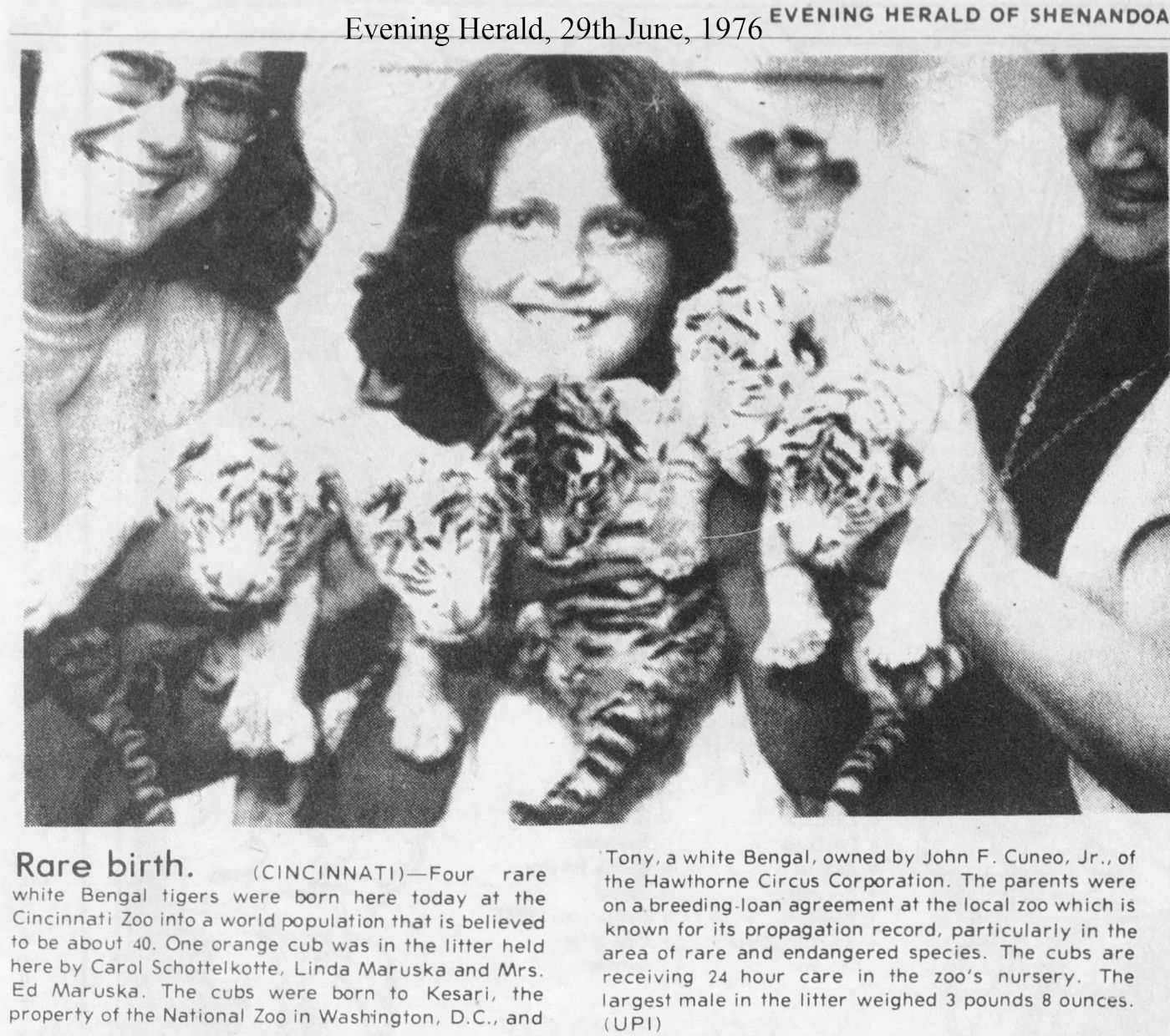
Kesari was bred to Tony, on breeding loan from the Hawthorn Circus, at Cincinnati Zoo in 1976. Tony had gone to Cincinnati to be bred to Rewati, not Kesari, and had the Tony-Rewati breeding occurred it would have resulted in only white cubs. In any event, Kesari produced more white cubs than expected. Tony-Kesari matings produced 80% white cubs rather than the expected 50%. Ramana-Kesari matings produced 75% white cubs instead of the expected 25%. Kesari went from Cincinnati zoo to HDZ, but produced no more cubs. Tony introduced Amur (Siberian) tiger blood into the zoo population of white tigers.
Chart C: The Merging of Bengal and Amur (large image, opens in new window)
Kesari's offspring Ranjit, Bharat, and Priya were all outcrossed with unrelated orange tigers to introduce fresh blood (heterozygotes bred from Bharat or Priya went to Gulf Breeze Zoo). The three were eventually sold to Hunt's Bros' International Animal Exchange (IAE) in 1987. NZP had a non-breeding brother and sister pair of orange Bengal tigers, offspring of Bharat and a supposedly pure Bengal from Knoxville, for many years. Kesari s four cubs were the last (studbook) registered (pure-bred) Bengal tigers born in the Western Hemisphere. Ranjit, Bharat, Priya and Peela have proved hard to follow up in the records as they are all marked lost to follow-up. They were all sold by the NZP in 1986 and would have been 12 years old and able to breed. Ranjit, Bharat, Priya and Peela have proved hard to follow up in the records as they are all marked lost to follow-up. They were all sold by the NZP in 1986, on the same day that Panghur Ban arrived there. One account says that Bharat, Priya, and Peela were sold to the International Animal Exchange, Sandusky, Ohio, while Ranjit, Priya, and Peela went to the IAE s facility in Grand Prairie, Texas. Ranjit and Bharat were then sold to a zoo by the IAE supposedly to a zoo in Formosa. According to other accounts, Ranjit went to the African Safari Wildlife Park in Sandusky, Ohio, while Bharat went to Royal Oak, Michigan, and Peela and Priya went to Hunts Bros' International Wildlife Park, Grand Prairie, Texas. Royal Oak is the office of Hunts Bros, International Animal Exchange and is directly opposite the Detroit Zoo. The Detroit Zoo apparently never exhibited white tigers, so Bharat was owned by the International Animal Exchange but it is unclear where she was warehoused.
The Lincoln Star 23rd March 1978 article "Two tigers secret riders aboard flight to Omaha" reports on Ranjit and Kesari flying from Washington DC with zoo keeper Arthur Cooper from the NZP (Cooper hand-reared Marvina, Kesari's daughter born in 1973.) This means Ranjit was at Washington 1976 1978 while too young to breed. On 15th August, 1978, a Nebraska newspaper proclaimed "Zoo awaits four new tigers to be delivered to the Henry Doorly Zoo here Sunday and Monday, officials say. Director Lee Simmons said it is hoped the tigers will produce another rare white cub through matings with one of the new tigers and the mother of a white tiger currently at the zoo."
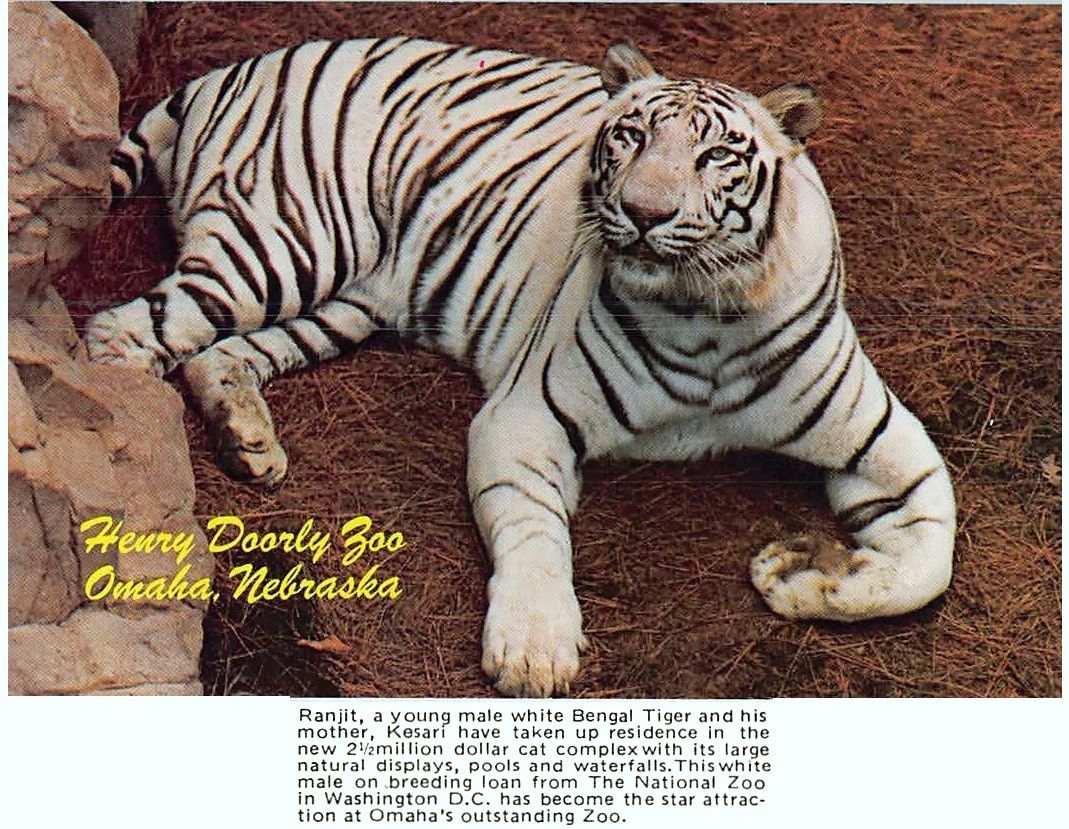
According to the Leipzig Tiger Zuchtbook, Priya was transferred to Knoxville on 5th April 1974, then to Ferndale (which is synonymous with Royal Oak) on 8th April 1983, and was transferred and lost to follow up as of 21st April 1986. Peela went to Ferndale on 4th Nov 1976 and was transferred and lost to follow-up on 30th April 1986. Bharat was transferred to Ferndale on 5th April 1976 and lost to follow-up on 30th April 1986 (along with Peela). Ranjit was transferred to Omaha on 5th April 1976, loaned to Ferndale on 21st March and lost to follow-up on 28th April 1986. So all 4 tigers ended up at Ferndale and were transferred and lost to follow-up in April 1986, which indicates they went into private ownership or were exported.
The African Safari Wildlife Park brochure (1987?) shows what looks like a pure-Bengal white tiger, and it says there are only 55 white tigers on earth. This appears to be Bharat in the IAE safari park at Port Clinton, Ohio, which means Bharat was not at Sandusky at that time. Port Clinton only had one white tiger while Grand Prairie had two (Ranjit and Priya). These two safari parks were "holding areas" until a buyer is found. Ranjit and Bharat were sold together to a zoo in "a Chinese-speaking part of Asia" and probably Priya and Peela were too; possibly they were sold as breeding pairs. Other tigers, such as Marvina, Raja, Sheba II, and Obie may also have spent time in one of these safari parks.
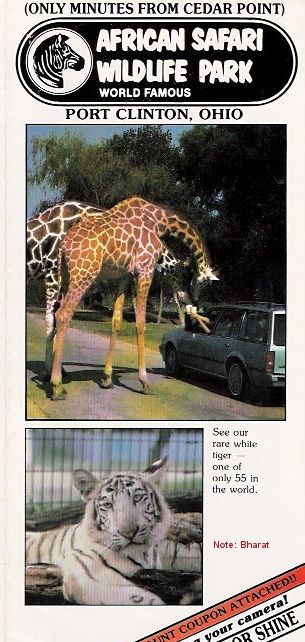
In 1973 an unrelated orange Bengal (actually Indo-Chinese) tiger named Poona was sent from Chicago Brookfield Zoo to Washington on six month loan to breed with either Mohini, Rewati or Kesari. Brookfield Zoo probably expected a share of any cubs he sired at Washington DC. When Poona, Mohini, and Rewati arrived back at the Brookfield Zoo together, the Zoo intended to continue their attempts to breed him with both Mohini and Rewati. According to Brookfield Zoo, Poona was born in Seattle 7th August 1962 and was listed as Panthera tigris corbetti (North Indochinese tiger). Poona of Chicago appears to have been confused by Sankhala and Thornton with a heterozygous orange tiger named Poona born at New Delhi zoo to Moti (male) and Homa (white daughter of Raja and Rani) also a mistake because Raja and Rani s daughter was Roma while Homa was the offspring of Mohan and Sukeshi. Poona of Chicago mated with 15 year old Mohini in 1973, but no cubs resulted. He was also bred to Kesari, resulting in 6 orange cubs in 1973; but only Marvina (female) survived (hand-raised). Brookfield Zoo stated that their Poona was not the heterozygote from New Delhi zoo as claimed by Thornton and Sankhala. Poona of Chicago fathered cubs by 2 other tigresses at Brookfield zoo and 50% would have been heterozygotes. One may have gone to Racine zoo. Neither Poona, nor Marvina were registered Bengal tigers nor listed in the white tiger studbook.
Poona of Delhi's mother Homa was quadruple first cousin to Kesari (all of their parents - Raja, Rani, Mohini, Samson - were siblings). According to Sankhala, Moti was an orange male, Moti captured in the forests of Panna in the neighbourhood of Rewa and taken to Delhi Zoo. At Delhi Zoo, Moti was paired with white females, Homa and Roma to produce heterozygous offspring and introduce fresh blood.
Prior to 1974, Cincinnati Zoo director, Ed Maruska, was anxious to acquire a white tiger, but zoos would not sell at any price. In 1974 Marvina, Kesari and Ramana were boarded at the Cincinnati Zoo during renovations in Washington. Zoo 2000 quoted Devra Klieman of the NZP as saying "I was well aware of the white gene and told Cincinnati not to breed from any of these tigers." NZP had attempted unsuccessfully to breed Ramana to Kesari prior to their successful breeding at the Cincinnati Zoo in 1974. Cincinnati Zoo responded that while Ramana and Kesari had refused to mate in Washington, they had mated almost as soon as they arrived in Cincinnati. The Ramana-Kesari mating produced 3 white and 1 orange cub, all healthy, born just after Ramana's death from a kidney infection. The cubs were white male Ranjit (sent to HDZ), 2 white females Bharat and Priya, and orange male Peela. These all returned to Washington. These were the last registered pure-bred Bengal tigers born in North America. Inbreeding for white tigers had coincidentally kept the Bengal bloodline pure.
Chart 3.1d: Ramana and Kesari's Offspring (large image, opens in new window)
Cincinnati Zoo had hoped that Ranjit, Bharat and Priya would remain on permanent loan in Cincinnati. Ranjit, Bharat, Priya and Peela have proved hard to follow up in the records as they are all marked lost to follow-up. They were all sold by the NZP in 1986, on the same day that Panghur Ban arrived there. - See the blue-coloured section further up the page. Marvina, aged 14, may have gone to Grand Prairie with them; she was not registered as a pure Bengal as her grandfather Moti (not to be confused with Cincinnati Zoo's Mota) was possibly of mixed ancestry, hence her father Poona could not be considered a pure Bengal.
In 1976 Cincinnati Zoo unsuccessfully tried to breed John Cuneo's Tony to Rewati. Tony was successfully bred to Kesari, resulting in 4 white and one orange cub in 1983. Although born to unrelated parents, the 4 white cubs developed crossed eyes (only one other cub, out of 70 born at Cincinnati Zoo, was cross eyed). The 2 white males returned to the Hawthorn Circus with Tony. Cincinnati Zoo kept a white pair named Bhim and Sumita along with orange female Kamala. Mexico City Zoo obtained white offspring of Bhim and Sumita (some may have been offspring of Bhim and Kamala). Bhim and Sumita became the world record parents of white tiger cubs.
About 25% of Bhim and Sumita's cubs were stripeless white tigers. Tapi (white daughter of Bhim and Sumita) may have been paired with Mota (white son of Bhim and Kamala) while at Los Angeles zoo, before moving on to San Diego zoo and eventually to the African Lion Safari in Ontario. African Lion Safari had a white tiger Calcutta (son of Bhim and Sundari) and in 1997, they had a white tiger cub Nicholas (son of Calcutta and Badfinger - a daughter of Bhim and Kimanthi). At Cincinnati, Bhim was outcrossed to unrelated orange Bengal tigress, Kimanthi, producing 5 litters. Kimanthi was on breeding loan to Cincinnati Zoo from Oakland Zoo, California, and the pairing resulted in Indira (Rajiv's mother) and Dolly. Bhim was also bred to his daughter Indira. According to Zoon, the Pretoria Zoo magazine, Indira shared Rajiv's enclosure at the National Zoo, even though she was Rajiv's mother and half-sister (being Bhim's daughter), and Rajiv was the product of a father-daughter mating.There was apparently an orange tiger named Moti who was born at the Cincinnati Zoo and lived at both the San Diego and Los Angeles zoos and who may have gone to the African Lion Safari in Ontario, Canada. If he was one of Bhim's sons he was not registered as Moti.
Chart 3.1a3: Bhim and Kimanthi's Offspring (large image, opens in new window)
Chart 3p1a1: Bhim and Sumita Pt 1 (large image, opens in new window)
Chart 3p1a1a: Bhim and Sumita Pt 2 (large image, opens in new window)
Chart 3p1a1f: Bhim and Sumita Pt 3 (large image, opens in new window)
Chart 3.1a2: Bhim and Kamala's Descendents (large image, opens in new window)
Chart 3p1a3b: Bhim and Indira's Descendents, showing the genetics of golden tabby (large image, opens in new window)
Chart 3.1a3: Bhim and Kimanthi Descendents (large image, opens in new window)
Chart 3.1a1b: Bhim and Sundari Descendents (large image, opens in new window)
Chart 3.1a1c1: Bhim and Tapi's Descendents (large image, opens in new window)
Chart 3.1a1c: Tapi, Naranga and Mota's (Bhim's Sons) Descendents (large image, opens in new window)
Chart 3.1a1b: Shubra (Bhim/Sumita Daughter) and Benzoo (Bhim/Kamala Son) and their Offspring (large image, opens in new window)
Chart 3.1a1b1: Bubba (Shubra/Benzoo Son) and Kipling and their Offspring (large image, opens in new window)
In the 1980s the Cincinnati Zoo was selling white tiger cubs sired by Bhim for $60,000 each. The zoo was criticised as being a "white tiger mill". When NZP decided to leave the white tiger business and sent their white carriers out, they specifically asked that the carriers not be bred for their white genes; Cincinnati Zoo ignored this request. Genealogies show that Bhim-Sumita (brother-sister) matings had more females born or surviving than males, indicative of an unhealthy level of inbreeding. Matings between Bhim and his daughters will make this even worse. Inbreeding also brought out the apparently recessive mutation for stripeless (snow white) tigers that may originally have come from Tony.
Siegfried and Roy bought a litter of 3 white cubs from Cincinnati Zoo (born in 1982) for $125,000 (at the suggestion of the Maharajah of Baroda, cousin of the Maharaja of Rewa and India's commissioner of wildlife at the time, who negotiated on their behalf). These were stripeless white tigress Sitarra ("Star of India"), Neva (snow") and Shasadee ("chosen one"). Stripeless Sitarra became the matriarch of Siegfried and Roy's "Royal White Tigers of Nevada." At the time it was believed that stripeless white tigers were sterile so Sitarra was included for the bargain price of $5000.
Chart 3.1c1: Ranjit and Soma's Descendents (large image, opens in new window)
Chart 3.1c: Ranjit, Ia and Tanya's Descendents (and Cherry & Maynard's line) (large image, opens in new window)
In the 1980s HDZ acquired Tony's parents Raja and Sheba II, and Tony's orange sister Obie, from the IAE (Baron von Uhl). In 1978, HDZ borrowed Ranjit (son of Ramana and Kesari) from NZP to breed with Obie. Ranjit's mother Kesari also went to HDZ, but produced no more cubs. Ranjit was bred to four tigresses, including an orange tigress from Muscatine (Weed Park Zoo, Iowa) and orange tigresses Soma and Tanya to widen the gene pool. The offspring were then crossed to produce both orange and white offspring. Ranjit-Obie matings produced both orange and white offspring. A brother and sister pair of supposedly pure-Bengal tigers (unregistered) from Knoxville Zoo were bred to Ranjit and Bharat in Washington (the female might have been Soma). In 2006, Omaha Zoo still had two of Ranjit's granddaughters (his last descendents were born 1998), one of whom was on loan to Michigan. According to Sara Iverson's ZooGoer article, a Bengal tiger (possibly not purebred) named Jack was sent from the San Francisco Zoo and bred to Bharat in Washington. Jack appears to have sired Kanchana, a tigress who later bore at least one white cub (possibly at Riverbanks Zoo, Columbia, South Carolina).
Columbus Zoo borrowed Ika (brother of Bhim and Sumita), a 3-legged amputee retired from performance, from the Hawthorn Circus. Ika was born at Cincinnati Zoo in 1976 and named Vir. He was bred to Rewati in 1984, even though both were cross eyed. According to the zoo "We took anything we could get." Ika and Rewati were gradually introduced over a 9 month period and were getting along well, but unfortunately Ika killed Rewati during mating. Ika was then paired with white tigress Taj, daughter of Dolly and Duke and granddaughter of half brothers Bhim and Ranjit. The Ika-Rewati mating produced a cross-eyed female Lilly. Ika was also bred to Taj's mother, orange tigress Dolly, on loan from Cincinnati zoo, resulting in 2 orange and one white cub in 1986.
Chart 2.2: Ika, Baby and Dolly's Descendents (large image, opens in new window)
Chart 2.6: Ari and Kashmir's Descendents (large image, opens in new window)
Dolly and Duke were the orange parents of Taj. Duke was Ranjit's son from an outcross and Dolly was Bhim's daughter from an outcross, ensuring Taj had fresh blood from both sides. Taj's siblings included one regular orange and 2 golden tabbies. Taj and Ika's offspring Yin and Yang, born at Columbus Zoo, went to the Hawthorn circus as part of their share from the breeding loan of Ika. The incestuous nature of breedings among Bhim, Ika and Ranjit (all offspring of Kesari) can be seen from the genealogies. Ika was returned to Hawthorn Circus at the conclusion of the breeding loan. Taj was also mated to Isson, a son of Arjun (Arie), in 1997. In 2006, Columbus Zoo had just one white tiger, an 8 year old striped male named Akere (or Akeer - Hindi for "last") on loan from Cincinnati Zoo when Taj died. When Akere returned to Cincinnati Zoo, he was castrated before being exhibited with white tigress called Popsie.
By this time, most of the white tigers in US zoos were mongrels and there was interchange of tigers between zoos and circuses, something that is unthinkable today. Mohini's blood lives on in many of them, but it would not be long before zoos became more conservation-minded and got out of the white tiger business in order to concentrate on pure-bred tigers. Circuses continued to breed white tigers, and there were several facilities that were little more than white tiger farms breeding them for sale to private collections and as performing animals.
Hawthorn Circus contined breeding tigers for 10+ generations. In November 2017, the Hawthorn Corporation, which leased tigers to circuses, had its licence cancelled following U.S. Department of Agriculture (USDA) reports on the avoidable deaths of dozens of tigers (e.g. hypothermia, dehydration, lack of veterinary care). The Hawthorn Circus tigers were uniform types, no stripeless white tigers or golden tabbies. In 2010, Adam Burck performed with six tigers: Krishna (male, white), Bo (male, orange carrying white gene), Java (female), Sher Khan, Natari (female, white), and Spartacus (male, white). White tigers Krishna, Natari, Spartacus were already adult in 2006 and were previously part of Wade Burck's act. Adam Burck s first tiger cubs were born 15th July, 2010 - two orange and two white. Parents were Bo (orange male, carrying white) and Natari (white female). According to the Sulphur Springs News Telegram, 10th April 2021, he was performing with four tigers: white tigers Isis and Ursula and gold (i.e. orange) tigers Kali and Sher Khan.
Textual content is licensed under the GFDL.
FOOTNOTE
Most white tiger websites have a pro- or anti-agenda and variously claim to give facts, truths or debunk myths but give misinformation or have hidden agendas. I stick to facts and deductions based on facts. Some information is documented, some is from personal correspondence with zoos, and some is from the recollections or personal notes of people involved with circus or zoo tigers where records were have been lost or destroyed. Even the different editions of tiger studbooks are inconsistent. Information from my pages, which are frequently updated, is widely copied on those other sites. Some sites have tried to claim I copied their work.
|
BACK TO HYBRID & MUTANT BIG CATS INDEX |